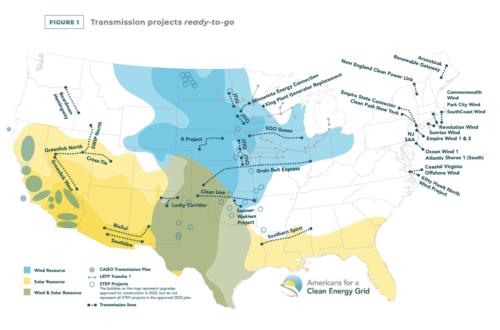Resource Hub
Transmission and the Economy
Every day, millions of American businesses and workers rely on the energy grid to power our economy. Thanks to a network of transmission lines that carry energy from where it’s generated to where it’s used, we can heat and cool our workspaces, run manufacturing equipment, keep the lights on, power our computers, and even charge our vehicles to get to work. Transmission is fundamental to powering our 21st-century economy — and yet, many of the transmission lines we depend on today were built more than 70 years ago. We’re way overdue for an upgrade.
Building better regional transmission will boost our economy by:
- Creating up to 3.3 million jobs nationwide
- Driving more than $15 billion in private capital investment
- Generating $2.3 billion in energy savings for working- and middle-class families
- Shoring up our grid security to make our energy system less vulnerable and more reliable
A 21st-century economy calls for a 21st-century grid.
An investment in transmission would create thousands of good-paying jobs all across America.
Americans for a Clean Energy Grid identified 36 shovel-ready high-voltage transmission projects that, if built, would add roughly 3.3 million good-paying union jobs in the transmission and clean energy sectors. An investment in regional transmission would also mean a big boost to American manufacturing because more than 60% of the materials used in transmission infrastructure are made in the United States.
Reliable energy is essential to a modern economy.
Building more high-voltage transmission lines would not only create jobs but also generate broader regional benefits for many parts of the US. Together, these projects could nearly double the nation’s clean energy capacity and infuse the economy with $30-$40 billion a year. Plus, these new transmission lines would aid in the transition to clean energy and help decarbonize America’s economy.

Building transmission could put billions of dollars back in the pockets of working- and middle-class families.
Just like our highways at rush hour, transmission lines get congested when there’s too much traffic and not enough capacity. This is happening more often as we experience extreme heat in the summers — and extreme cold in the winters — forcing everyone to reach for the thermostat at once. During these “rush hours,” congestion prevents grid operators from sending enough lower-cost energy to meet the demand and forces them to instead dispatch higher-cost energy from other sources. As a result, grid congestion cost American families and businesses over $20 billion dollars in 2022 alone. Building more transmission lines would expand our grid’s capacity and allow us to tap into the lowest-cost sources of energy when we need them most. A more robust transmission system could save working and middle-class Americans $2.3 billion every year on their energy bills.
A robust transmission system is the key to improving national security, disaster preparedness, and community resilience.
In recent years, experts have begun sounding the alarm about the growing vulnerability of America’s energy infrastructure due to physical attacks, cyber attacks, and extreme weather. With our nation’s schools, hospitals, emergency services, and military bases all relying on the power grid to perform their most basic functions, the stakes are too high for our energy system to fail. Investing in interregional transmission planning and expanding transmission infrastructure will improve our energy system’s flexibility and resilience and make it more difficult for bad actors to damage the grid.
Additional Resources
Additional Links
-
Large-scale Transmission Deployment Saves Consumers Money
ACEG
-
State Policies to Advance Transmission Modernization
ACEG
-
Transmission: Expanding Transmission Helps Local Economies, Strengthens Electric Grid
American Clean Power
-
2023 Transmission Congestion Report
Grid Strategies
-
High Voltage, High Rewards
RMI
-
The State Regulator’s Role in Transmission
RMI
-
Paving the Way for Cost-Effective Transmission
RMI